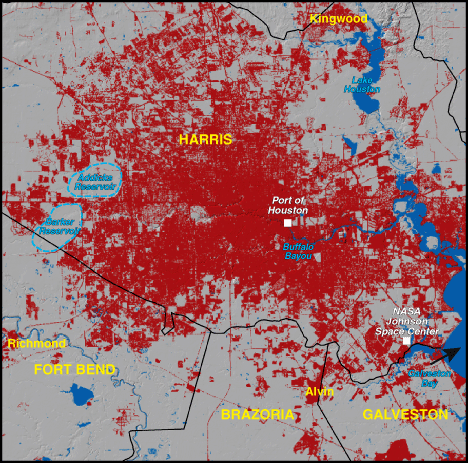Houston, Texas 1973


|
1970 Population - 2,072,350
Includes Harris, Fort Bend, Brazoria, and Galveston Counties. NOTE: portions of the above listed counties may not be visible on the map Red areas shown as developed land 263,700 acres (412 square miles) |
Houston was established in 1836 at the supposed "end of navigation" on the Buffalo Bayou. The city had access to the Gulf of Mexico via Galveston Bay, but 80 years would pass before a true seaport was created, primarily because of federally funded dredging. Houston grew as a commercial center, servicing hinterland activities that included forestry in east Texas and agriculture in the interior plains. By 1930, the city was an industrial center thanks to Gulf coast petroleum resources and the development of the port. Houston became a leader in the American oil industry, especially after the Federal Government helped establish petrochemical facilities there in the 1940s. |
Houston, Texas 1992

|
1990 Population - 3,452,625
Includes Harris, Fort Bend, Brazoria, and Galveston Counties. NOTE: portions of the above listed counties may not be visible on the map Red areas shown as developed land 482,700 acres (754 square miles) |
During the post-World War II era, Houston benefited from the expansion of the oil and petrochemical industries, the "progrowth, probusiness" philosophy of civic leadership, and national migration to the Sunbelt. The economic synergy helped foster facilities not related to oil, such as major medical complexes and the Johnson Space Center. The city's continued growth has, however, caused regional problems, including water and air pollution, waste disposal, ground subsidence from extensive ground water pumping, flooding because of increased runoff from urban surfaces, and traffic congestion. |